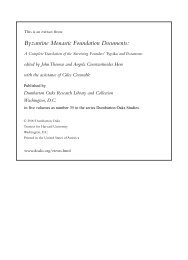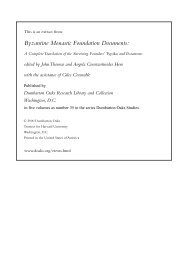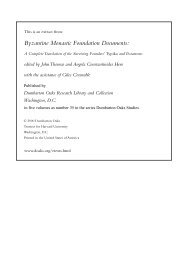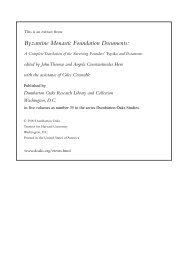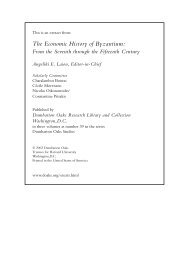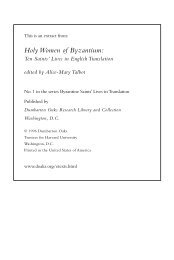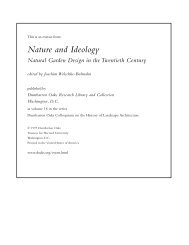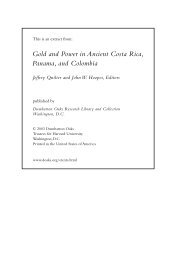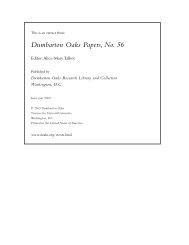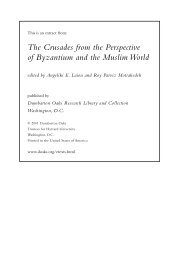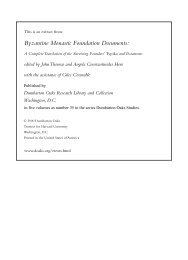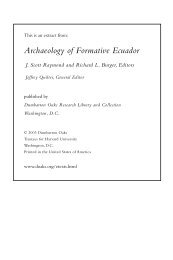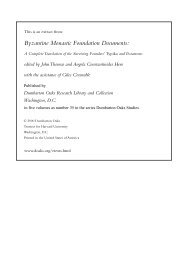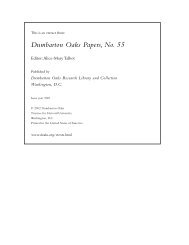7. Life of St. Theodora of Thessalonike - Dumbarton Oaks
7. Life of St. Theodora of Thessalonike - Dumbarton Oaks
7. Life of St. Theodora of Thessalonike - Dumbarton Oaks
You also want an ePaper? Increase the reach of your titles
YUMPU automatically turns print PDFs into web optimized ePapers that Google loves.
<strong>St</strong>. <strong>Theodora</strong> <strong>of</strong> <strong>Thessalonike</strong> 169<br />
location and situation and the peaceful living conditions, and that as a result<br />
<strong>of</strong> its protection by its guardian and defender, the all-glorious martyr Demetrios<br />
37 (second only to God), it was protected from all evil assaults and remained<br />
impregnable. <strong>Theodora</strong>’s father, who desired peace and quiet and detested<br />
the iconoclast faction, loathsome to God (for the holy Church was still<br />
controlled by them, through some oversight <strong>of</strong> God), 38 retired to the remote<br />
area below Thoropa, 39 which is not frequented by men, in the belief that it was<br />
easier to live among wild beasts than to associate 40 with people <strong>of</strong> false belief,<br />
so that he might be able to see God to as great an extent as possible and to<br />
become blessed. And he spent the remaining years <strong>of</strong> his life here in a pious<br />
manner, inasmuch as he enjoyed freedom from worldly cares and could live<br />
the ascetic life in peaceful contemplation. He left everything to those<br />
who wanted it, and communing constantly with himself and with the <br />
Spirit, he departed this human life, and flew <strong>of</strong>f to the heavenly abodes.<br />
8. But they [i.e., <strong>Theodora</strong> and her husband] decided to live in the city.<br />
They had three children, <strong>of</strong> whom the second and third died soon , 41 adding great sorrow to their distress at living in a strange place and<br />
the loss <strong>of</strong> their possessions. But not even this terrible, indeed exceedingly<br />
terrible, and great blow prevailed in the end over that woman’s noble<br />
and virtuous soul. [p. 80] On the one hand, did overwhelm her,<br />
inasmuch as she was a mother, and, as in the case <strong>of</strong> mothers, her nature was<br />
overwhelmed in this as in all things; but unlike most women, she was not swept<br />
away by the tragic event, her reason giving way to her suffering. Rather she<br />
used reason to withstand her suffering, and became a support for her husband<br />
in his despondency, saying: “I have heard the Holy Writ explain that ‘the head<br />
<strong>of</strong> the woman is the man’ 42 and that ‘the members should have the same care for<br />
37 Tradition holds that Demetrios, the patron saint <strong>of</strong> <strong>Thessalonike</strong>, was martyred<br />
there under the emperor Maximian (286–305).<br />
38 Gregory is referring to the imperial policy <strong>of</strong> persecuting those who venerated the<br />
images <strong>of</strong> Christ, the Virgin and saints. The second period <strong>of</strong> iconoclasm (lit., “breaking<br />
<strong>of</strong> icons”) lasted from 815 to 843.<br />
39 An unknown place probably in the vicinity <strong>of</strong> <strong>Thessalonike</strong>.<br />
40 “Retired to . . . associate”: cf. Basil <strong>of</strong> Caesarea, Homilia in Gordium martyrem,<br />
PG 31:496b.<br />
41 An indication <strong>of</strong> the high infant mortality in Byzantium; cf. also note 324 in Chap.<br />
13 <strong>of</strong> the Translation and Miracles, and G. Contis, “Patterns <strong>of</strong> Disease and Death<br />
among Women and Children in Early Byzantine Times,” BSCAbstr 19 (1993), 34–35.<br />
42 1 Cor. 11:3.




